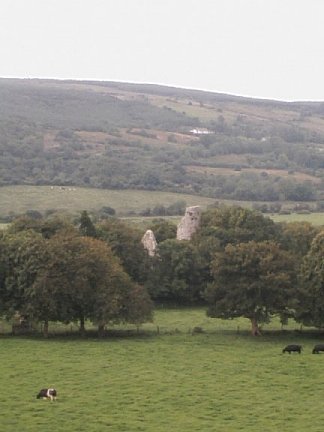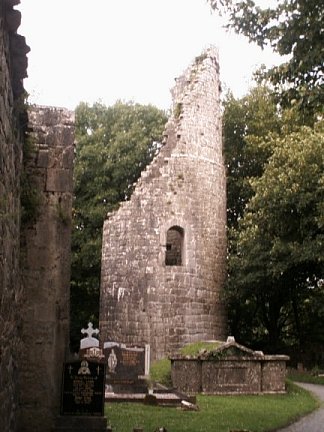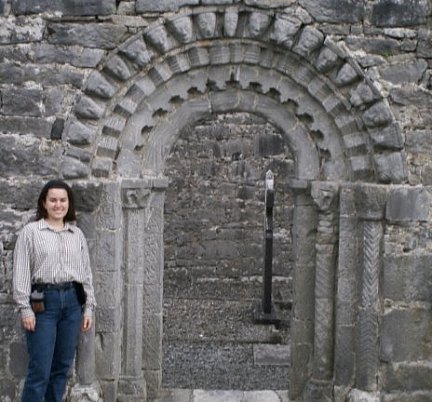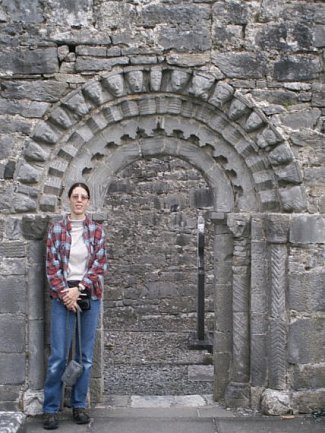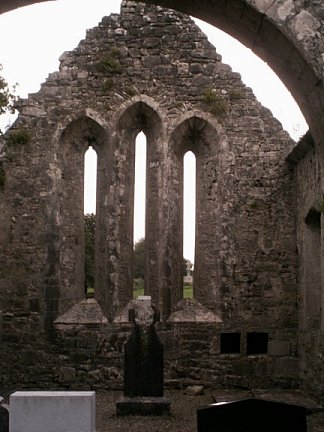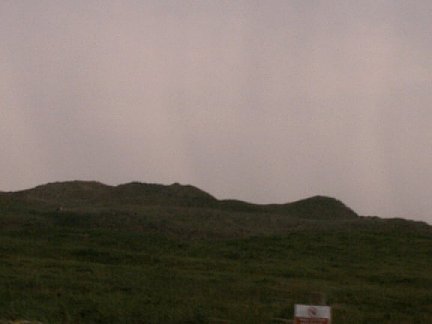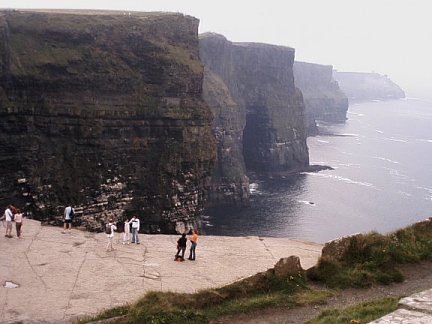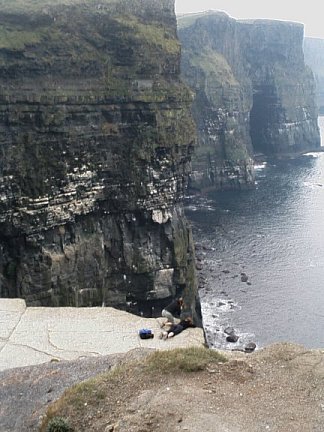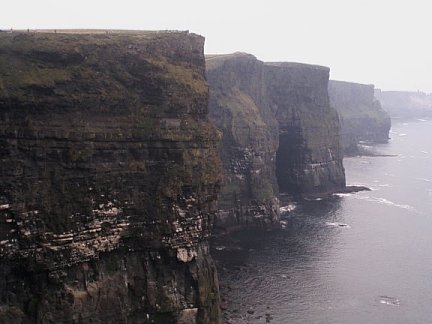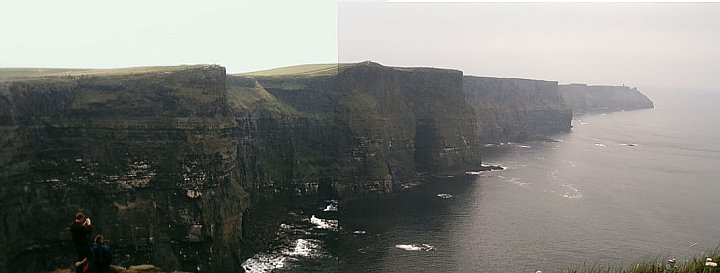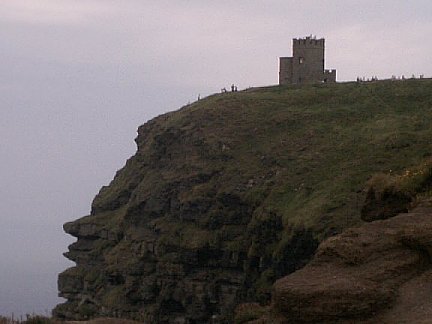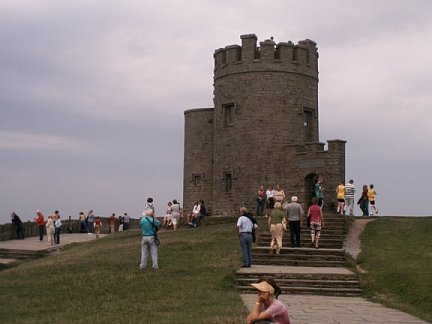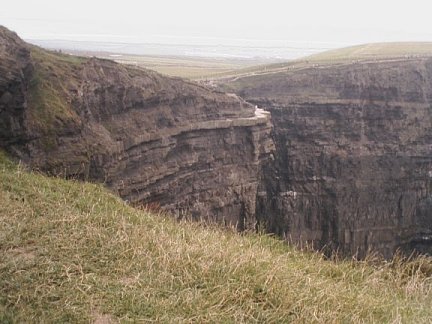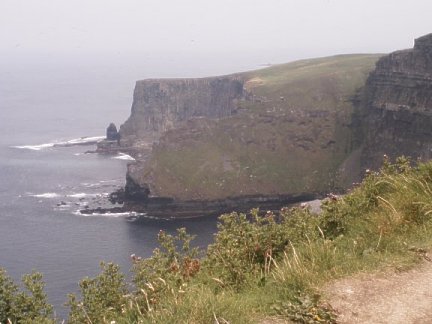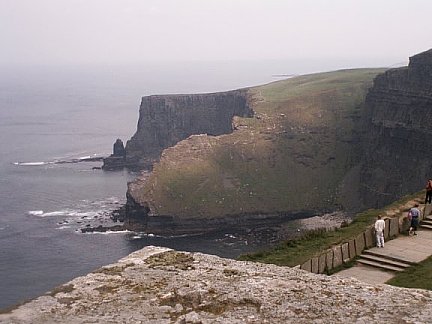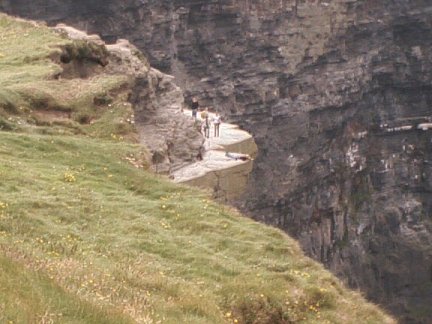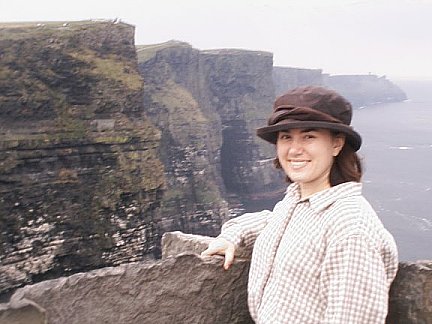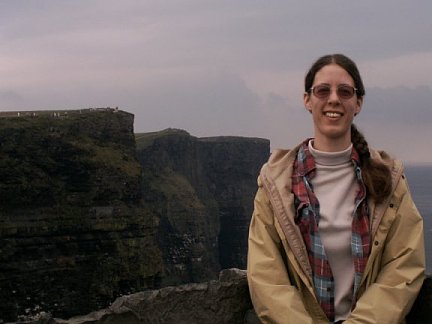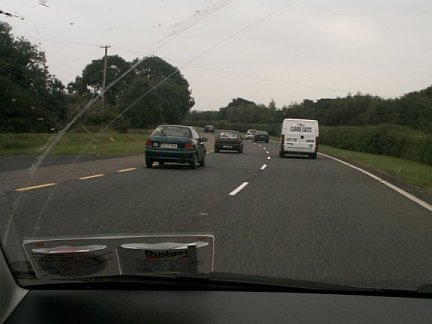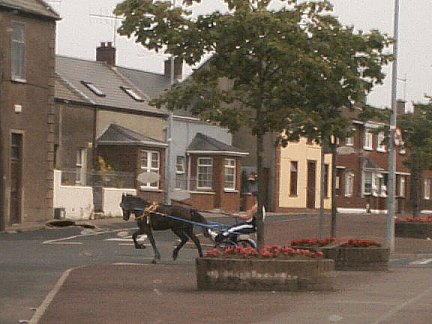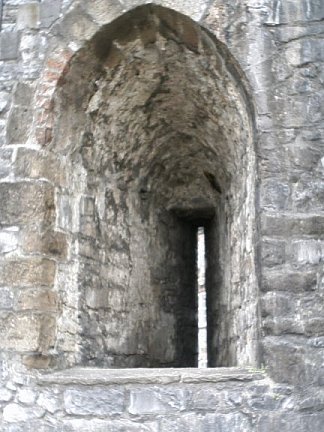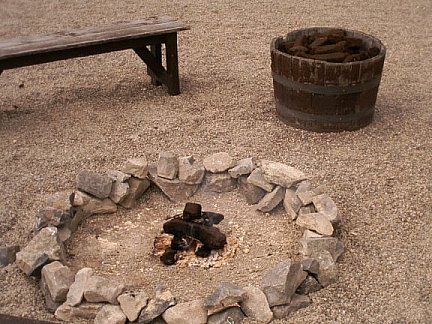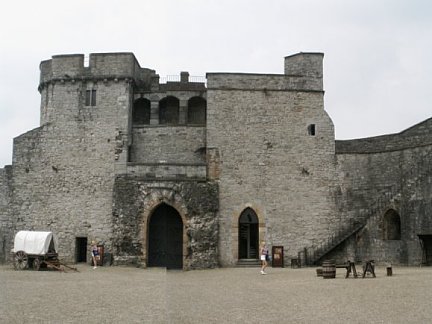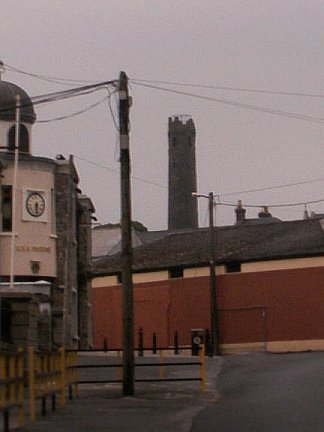The second half of Bed-and-Breakfast, is of course the breakfast. Ours consisted of: tea with milk and sugar, whole grain bread with butter and raspberry preserves, homemade yogurt with strawberries and rhubarb, porridge with cream and brown sugar for me and muslix with milk for Sarah, and a "traditional Irish breakfast" consisting of a fried egg, 2 rashers of bacon (more like ham than bacon as we know it), and 3 different sausages. No, I didn't eat the sausage, but I had a good excuse - I was stuffed from all the rest of it!
We set out after breakfast, heading toward Ennis, and stopped at Dysert O'Dea, a tower house, round tower and old church remains, and the High Cross of St. Tola. Dysert Castle (the tower house) was built in c. 1480 by Diarmuid O'Dea and was the strong house of the O'Dea clan until 1691.
 In 1970, it was bought and restored by an O'Dea descendent (from Wisconsin). You could see the old church and round tower from the top of the tower house and after visiting the house itself we drove the car over there. The church had a nifty carved arch doorway that we took each other's picture next to, and if you look carefully through the far right window of the church, you can just make out the high cross in the field beyond. (We didn't walk out to it for closer photos.)
In 1970, it was bought and restored by an O'Dea descendent (from Wisconsin). You could see the old church and round tower from the top of the tower house and after visiting the house itself we drove the car over there. The church had a nifty carved arch doorway that we took each other's picture next to, and if you look carefully through the far right window of the church, you can just make out the high cross in the field beyond. (We didn't walk out to it for closer photos.)
 |
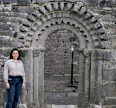 |
 |
 |
As we got back on the road, I suddenly realized that we had skipped the Cliffs of Moher,
 so we backtracked back up the road to Corofin where we'd seen a road to Ennistymon. We passed some odd looking hills on the way to the Cliffs (completely overgrown ancient ruins) and arrived at the coast at noon. The skies were cloudy, especially out to sea, where a thunderstorm was brewing, but the sun came out from behind them often enough that we got some very nice pictures during the 2 hours that we were there.
so we backtracked back up the road to Corofin where we'd seen a road to Ennistymon. We passed some odd looking hills on the way to the Cliffs (completely overgrown ancient ruins) and arrived at the coast at noon. The skies were cloudy, especially out to sea, where a thunderstorm was brewing, but the sun came out from behind them often enough that we got some very nice pictures during the 2 hours that we were there.
 |
 |
 |
 |
||
At the top of the path that follows the coast away from the Cliffs, there is a tower that you can pay €1 to climb up. I took some photos from the bottom of the tower; Sarah went up it and took some as well, including one with my camera.
 |
 |
 |
 |
 |
 On the way back down the path, we took pictures of some VERY daring people out on a little ledge. If you look closely, there is a guy on his stomach peering over the edge, straight down to the water far below.
On the way back down the path, we took pictures of some VERY daring people out on a little ledge. If you look closely, there is a guy on his stomach peering over the edge, straight down to the water far below.

 We stopped for photos next to the Cliffs, then it was back to the car and on the road to Limerick.
We stopped for photos next to the Cliffs, then it was back to the car and on the road to Limerick.
Back through Ennistymon and Ennis, and I had to take a photo of the road from Ennis to Limerick - it was huge!
 Two whole lanes of traffic going the SAME direction. I think we actually hit 75mph for a little while. Heheh. After spending two days straight on tiny 1 to 1.5 lane roads, this one seemed huge, anyway...
Two whole lanes of traffic going the SAME direction. I think we actually hit 75mph for a little while. Heheh. After spending two days straight on tiny 1 to 1.5 lane roads, this one seemed huge, anyway...
 On the way into Limerick, we passed a horse pulling a racing surrey. I guess they were training, although the asphalt roads of a city seem an odd place to do so.
On the way into Limerick, we passed a horse pulling a racing surrey. I guess they were training, although the asphalt roads of a city seem an odd place to do so.
Our big event in Limerick was the touring of King John's castle. According to the plaque:
 "The castle was built by Prince John of England c.1210, later to become King, to protect and maintain Norman power in Limerick and Munster." THIS was a real castle, and not some glorified tower house. Walls, and towers, and tiny slits for windows, some of which were designed so that archers could shoot at the enemy from them.
"The castle was built by Prince John of England c.1210, later to become King, to protect and maintain Norman power in Limerick and Munster." THIS was a real castle, and not some glorified tower house. Walls, and towers, and tiny slits for windows, some of which were designed so that archers could shoot at the enemy from them.
 There were several peat brick fires burning in the courtyard, which smelled more like a wood fire than I expected of burning soil.
There were several peat brick fires burning in the courtyard, which smelled more like a wood fire than I expected of burning soil.
Inside one of the towers was a sign giving further explanations of the castle's origins and purpose: "King John's Castle was begun between 1200 and 1212 on John's instructions, as part of his strategy for governing Ireland. He saw his role here as one of a peacemaker, balancing power between his Gaelic and Norman chiefs and barons. Limerick was important in achieving this plan, positioned on the Shannon and on the boundary between the Norman lands of Munster and Gaelic Thomond.
"King John's Castle was built, principally, for administrative purposes - it accommodated the King's man in Limerick, the Constable, with his small garrison. The Constable was the King's eyes and ears, and his function was to anticipate trouble and defuse situations before they erupted into warfare.
"To work effectively, the castle had to be a strong, safe place. King John's Castle at Limerick was as up-to-date as a castle could be in 1212; in that year £733.16.11 was spent on construction work."

Apparently John wasn't well liked by the people of Ireland, and never actually visited his castle in Limerick.
 On the way out of limerick, I managed to snap a picture of an intact round tower (unlike the one we saw at Dysert O'Dea), and then I found a store with "SPRATTS" on the side! I didn't take a picture with my digital camera because I knew that by the time it had taken its 10 seconds to turn on, we'd be past the building, so I tried taking one with my film camera, instead, but that didn't turn out either. Alas that I failed to document my ONE finding of the family name in Ireland.
On the way out of limerick, I managed to snap a picture of an intact round tower (unlike the one we saw at Dysert O'Dea), and then I found a store with "SPRATTS" on the side! I didn't take a picture with my digital camera because I knew that by the time it had taken its 10 seconds to turn on, we'd be past the building, so I tried taking one with my film camera, instead, but that didn't turn out either. Alas that I failed to document my ONE finding of the family name in Ireland.
From Limerick, we took the N7 back to Dublin. 700 miles in 3 days - a right nice little holiday . . .

